
Distribution Map

Description (Barlow 1993)
Lepeostegeres deciduus Barlow, Austral. J. Bot 22 (1974) 550. - Type: Brass 31467 (holo L 961. 149-196; iso CANB, K), New Guinea, Mt Michael, NE slopes, 2000 m, 9.ix.1959.
For description see Barlow, Austral. J. Bot 22 (1974) 550. The species can be identified by its combination of leaves dull on both sides and not bifacial, involucre c. 20 mm long with bracts deciduous at anthesis, and flowers in the inflorescence c. 20 and completely sessile. Involucre colour has not been recorded, but the flower colour is described as yellowish brown.
The species is distributed in New Guinea (Fig. 12; 8 collections seen), with a very small area in the Eastern Highlands, mostly at elevations from 1500 to 2000 m, but recorded down to 1036 m. Habitat details are poorly known, but the species apparently occurs in rain forests, and has been recorded as parasitic on Castanopsis.
Lepeostegeres deciduus is probably related to the Philippine L. congestiflorus
with which it shares the apparently derived character state
of involucral bracts deciduous after anthesis (for differences
from this species, see under L. congestiflorus). The species
shows a major geographical disjunction from the other species
of the genus, occurring to the east of Charles's line. It is presumably
a specialized derivative in New Guinea of an intrusive Malesian
stock, having a similar migration pattern to the related Decaisnina,
Amylotheca, and Cyne.
Description (Barlow 1974)
Lepeostegeres deciduus Barlow, sp. nov.
Type.-New Guinea, Mt. Michael, NE. slopes, 2000 in alt., Brass 31467, 9.ix.1959 (L 961149196, holotype; CANB 103247; K).
Glabra. Internodia basi teretia vel angularia, apice applanata ancipita. Folia opposita; lamina elliptica vel late ovata, 6-12 cm longa, 4-7 cm lata, tenuis, distincte penninervis, apice rotundata, basi breviter attenuata; petiolus alatus distaliter, 5-8 mm longus. Inflorescentiae singulae in axillis ortae; pedunculus 4-5 mm longus, apice 5-7 mm latus; fibres c. 20, in apice plano pedunculi sessiles conferti, vere in 6 vel 7 triadis decussatim dispositi; bracteae involucrales mox deciduae, pleruinque in paribus 3, quarum par exterius ovatum, c. 15 mm longum, c. 12 mm latum, interius oblongum, c. 20 mm longum, c. 5 mm latum et triada exteriora subtenens, bracteae aliter angustae lanceolatae, aequantes calycem vel ad squamas redactae, pleruinque triada completa et fibres laterales subtentes. Calyx prismaticus; limbus c. 1 mm longus, erectus, membranicus. Corolla in alabastro maturo tenuis, leviter clavata, acuta, 35-40 mm longa, in loco reflexionis c. 9 mm sub apicem incrassata; tubus corollae 18-24 mm longus. Antherae 4-6 mm longae; pars liberae filamenti parum breviores. Stigma quam stylus duplo latius. Fructus ellipsoideus, c. 8 mm longus.
Glabrous. Stem internodes terete or angular below, flattened and double-edged above. Leaves opposite; petiole winged distally, 5-8 mm long; lamina elliptical to broad ovate, thin, 6-12 by 4-7 cm, shortly attenuate at the base, rounded at the apex; venation distinctly pennate. Inflorescences solitary in the axils; peduncle 4-5 mm long, 5-7 mm wide at the apex; flowers about 20, crowded and sessile on the flat apex of the peduncle, actually arranged in six or seven triads in decussate pairs and sometimes with a central triad; involucral bracts deciduous, usually in three pairs; outermost pair ovate, c. 15 by 12 cm; innermost pair oblong, c. 20 by 5 mm, sub-tending the outer triads; other bracts narrow lanceolate, as long as the calyx, or reduced to scales, usually visible subtending both whole triads and lateral flowers. Calyx angular by mutual pressure; limb c. 1 mm long, erect, membranous. Corolla in the mature bud slender, weakly clavate, thickened at the point of reflexion c. 9 mm below the apex, acute, 35-40 mm long; petals in the open flower united in the lower 18-24 mm. Anthers 4-6 mm long; free parts of the filaments slightly shorter. Stigma twice as wide as the style. Fruit ellipsoidal, c. 8 mm long. (Fig. 1, h-k.)
Occurrence. Eastern New Guinea, recorded only from the Eastern Highlands District (Fig. 3), 1520 to 2000 m altitude.
Specimens Examined. EASTERN NEW GUINEA: Aiyura, c. 1830 rn alt., Smith NGF 1049, Oct. 1944 (L; LAE); Kini Ck., Mt. Michael, 2000 rn alt., Womersley NGF 11426 and 11718, 3.ix.1959 and 7.ix.1959 (CANB; L); Mt. Michael, N. slopes. 2000m alt., Brass 31146, 22.viii.1959 (CANB; K; L); near Perosa, c. 18 miles SW. of Okapa, 1520 m alt., Hartley 13198, 30.ix.1964 (CANB; L); between Kainantu and Okapa, c. 1830 m alt., Hartley 12117, 25.vii.1963 (CANB; L).
Lepeostegeres deciduus is unique in the genus in having all flowers completely sessile. It is also distinctive in having deciduous involucral bracts, a condition shared only with the Philippine species L. congestiflorus (Merrill) Merrill, with which it appears to be closely related.
This is the first record of the genus for New
Guinea. From its morphology and distribution, L. deciduus
appears to be an endemic of local origin that has developed under
conditions of prolonged genetic isolation.
Illustrations

Lepeostegeres deciduus. A - twig with inflorescences. B - twig with immature inflorescences showing bracts. C - open flower with front section cut away. D - part of twig with fruit. From Barlow (1981).

Lepeostegeres deciduus. A - portion of plant with young inflorescence. B - surface view of peduncle showing flower and bract scale scars. C - young inflorescence, showing deciduous bracts. D - mature inflorescences. From Barlow (1974).

Lepeostegeres sp. 2 - showing two recently emerged young capitula flanking the aborted shoot apex. Womersley 11718, K. 3 - same, inflorescence almost expanded. 4 - mature inflorescence with all bracts removed. Womersley 11426, K. From Kuijt (1981).
Photographs

Eastern Highlands District, north slopes of Mt. Michael, 2000 m elev. Collected by L. J. Brass (no. 31146), 22 Aug. 1959.

Near Perosa, 18 miles southwest of Okapa, 5000 ft. elev. Coll. by Thomas G. Hartley (no. 13198), 30 Sept. 1964.
Lepeostegeres deciduus
updated 20 January 2007